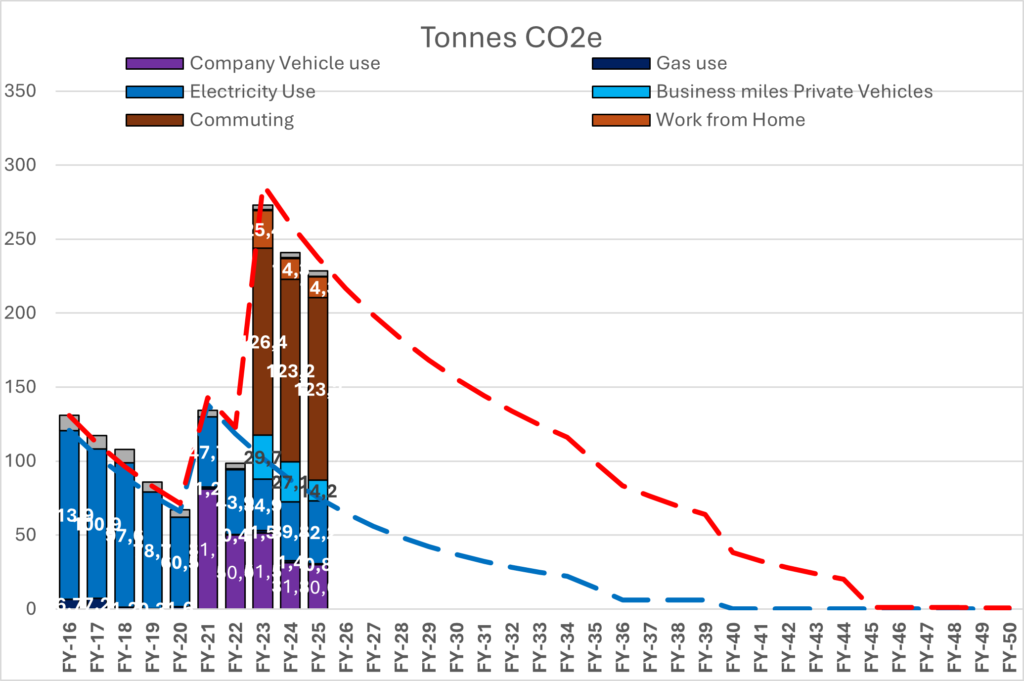Supplier Name: European Electronique Ltd.
Commitment to achieving Net Zero
European Electronique Ltd is committed to achieving Net Zero emissions by 2050.
Baseline Emissions Footprint
By definition, baseline emissions represent a record of the greenhouse gases produced in the past, specifically before any emission reduction strategies were put into place. For accurate measurement, baseline emissions serve as the reference point against which any future emissions reduction can be tracked and evaluated.
| Baseline Year: 01/04/20 – 31/03/21 (FY21) |
| Additional Details relating to the Baseline Emissions calculations. |
| In our baseline year we were measuring all scope 1 & 2 emissions but only Transmission & Distribution losses for electricity from scope 3. |
| Baseline year emissions: |
| EMISSIONS | TOTAL (tCO2e) |
| Scope 1 | Company Vehicle use 81.14 Gas use 1.17 Total Scope 1 82.30 |
| Scope 2 | Electricity use 47.72 |
| Scope 3 (Included Sources) | Electricity T&D Losses 4.10 Total 4.10 |
| Total Emissions | 134.13 |
Current Emissions Reporting
Reporting Year: Reporting Year: April 2024 – March 2025 (FY25)
| EMISSIONS | TOTAL (tCO2e) |
| Scope 1 | Company Vehicle use 18.549 Gas use 1.337 |
| Scope 2 | Electricity use 38.598 |
| Scope 3 (Included Sources) | Business miles in private vehicles 20.674 Commuting 116.292** Work from Home 13.812 Waste Processing 0.115 Water & Sewage 0.112 T& D losses 3.411 Total scope 3 154.417 |
| Total Emissions | 212.902 |
Emissions reduction targets
Please note:
- **Data for commuting are taken from voluntary surveys of staff. Not all staff re-sponded, and numbers are scaled up to account for this, but inevitably means there is some uncertainty in the figures.
- 151.005 t CO2e from scope 3 emissions are now included which weren’t in the Base year (FY21) figures.
We have also brought into our carbon reporting from the year ended 31st March 24 (FY24), emissions from:
- Business miles in private vehicles
- Commuting
- Work from Home
- Waste Processing
- Water & Sewage Processing
We intend to bring into our reporting, from the financial year commencing 01/04/25:
- Freighting goods, both upstream and downstream
- Flights
- Other public transport
- Hotel stays.
In order to continue our progress to achieving Net Zero, we have adopted the following carbon reduction targets.
We project that carbon emissions will decrease over the next five years to 155.510 tCO2e by end of March 2030. This is a reduction of 27%.
Progress against these targets can be seen in the graph below:

Carbon Reduction Projects
Completed Carbon Reduction Initiatives
The following environmental management measures and projects have been completed or implemented since the 2021 baseline. The carbon emission reduction achieved by these schemes equate to 58.25 tCO2e, a 43%ge reduction against the 2020/21 baseline and the measures will be in effect when performing the contract.
Carbon Reduction Projects
Completed Carbon Reduction Initiatives
The following environmental management measures and projects have been completed
- 2017/18. Removed gas heating from warehouse and replaced with heated office.
- 2017/18. First floor lighting replaced with LED controlled by sensors
- 2018/19. Decision not to purchase new packaging but re-use suppliers packaging.
- 2019/20. Start working towards paperless office.
- 2020/21. Ground floor lighting replaced with LED.
- 2020/21. Decision made to Isolate all Night Storage heaters in the building to prevent waste.
- 2021/22. Office open hours reduced by 1.5 hours / day.
- 2021/22. Fleet 4.3% Electric/Hybrid
- 2022/23. Continued hybrid working established during pandemic to reduce emissions from commuting.
- 2022/23. Heat pump heating installed in Main Service office on ground floor .
- 2022/23. Dual Car charging post installed in car park.
- 2022/23. Replaced convector heaters with Heat Pump heating in ground floor staff breakout room
- 2022/23. Fleet 6.3% Electric/Hybrid
- 2023/24. Fleet 26.7% Electric/Hybrid
- 2024/25. External building floodlights replaced with LED to reduce electricity
- 2024/25. Fleet, 3 / 7company owned vehicles electric (43%)
Improvements medium term:
We are committed to replacing gas heating with electric by 2035 (if there is no other green alternative to gas).
We operate an Environmental Management system certified to IS014001. In the future we will implement our carbon Reduction Strategy
Carbon Reduction Strategy
In order to continue our progress to achieving Net Zero, we have adopted the following carbon reduction strategy.
Our Short-Term (Immediate) Strategy is Reduce Waste.
Consistent with this approach we will:
- Minimise C02e from electricity use by:
- Switching electrical equipment off when there is no business benefit to leaving it on,
- Considering the environmental impact of new electrical equipment unless there are other compelling business reasons not to do so.
- Minimise C02e from gas use by ensuring that hot water is not wasted
- Minimise C02e from use of company vehicles by:
- Reducing Average C02e emissions of the fleet,
- Reducing the amount of company miles travelled by considering other alternatives to travel where feasible.
- Minimise C02e from processing of waste by applying the waste hierarchy.
We will continuously challenge the status quo and look for opportunities to reduce wasted energy and materials.
Mid-term Strategy
Company Vehicle Use (Scope 1 wholly owned)
All replacement company vehicles will be battery powered unless operational constraints make this unworkable. This will ensure that emissions from company vehicles will be zero from 2035.
Note 1: The UK Government is committed to the grid being green by 2035 so carbon from electricity will be removed from that date( Plans unveiled to decarbonise UK power system by 2035 – GOV.UK (www.gov.uk)).
Gas Use (Scope 1 wholly owned)
Although gas use in the building is minimal, if there is no low carbon alternative for gas for water heating by 2035, we will change to electric heat-pump water heating. As the grid should be green at this point this will eliminate emissions from gas.
Electricity Use (Scope 2 wholly owned)
The UK Government has committed to the grid being green by 2035 so carbon from electricity (including scope 3 T&D losses) will be removed from those dates.
Providing the UK Government meets its commitment our Mid-term strategy will result in our scope 1 and 2 emissions being eliminated by 2035.
Long-term strategy
Commuting
The vast majority of our employees currently commute by car. By 2050 only cars older than 15 years will still be non-electric. The current average age of cars used for commuting is 7 years so we expect to see a significant reduction in emissions from commuting as cars become greener although this will lag company vehicles. Where there are residual emissions, we will consider taking actions to encourage the change to greener vehicles and/or share the responsibility with the employees concerned.
Business miles in private vehicles (Scope 3 shared)
We currently have a relatively small footprint in this area. After 2040 we will only authorise business miles in private vehicles where the private vehicle is electric or another green alternative.
Waste Processing (Scope 3 shared)
Waste processing currently amounts for a very small proportion of our overall emissions.
Our company will work with all our partners to reduce the amount of waste in our supply chain. We will continue to keep an open mind and review new options as they arise to reduce waste.
We will continue to look for further opportunities to segregate new recyclable streams from our general waste.
Water / Sewage processing (Scope 3 shared)
Although water use /sewage processing currently amounts for the least proportion of our overall emissions as we don’t use water in our processes, we will ensure water is not wasted by applying our objective of Reduce Waste. We will continue to identify ways to share the responsibility for any residual carbon emissions.
Declaration and Sign Off
This Carbon Reduction Plan has been completed in accordance with PPN 06/21 and associated guidance and reporting standard for Carbon Reduction Plans.
Emissions have been reported and recorded in accordance with the published reporting standard for Carbon Reduction Plans and the GHG Reporting Protocol corporate standard and uses the appropriate Government emission conversion factors for greenhouse gas company reporting .
Scope 1 and Scope 2 emissions have been reported in accordance with SECR requirements, and the required subset of Scope 3 emissions have been reported in accordance with the published reporting standard for Carbon Reduction Plans and the Corporate Value Chain (Scope 3) Standard .
This Carbon Reduction Plan has been reviewed and signed off by the board of directors (or equivalent management body).
Signed on behalf of the Supplier:

Steve Mason – Company Secretary/Framework Manager
Date: 14/08/2025








